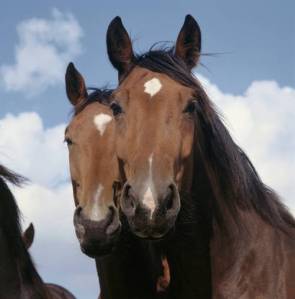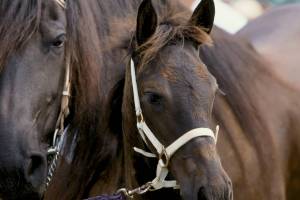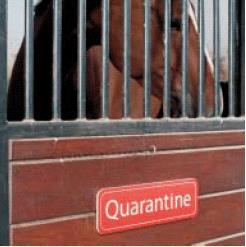Equine Herpesvirus Infection (EHV)
A page about equine herpesvirus infection describing cause, clinical signs, diagnosis and control.

Introduction
Equine herpes virus infections are commonly associated with sporadic outbreaks of disease in horse populations including respiratory disease, abortion, neurological disease, ocular disease and coital exanthema.
Aetiology
Equine herpes viruses belong to the family Alphaviridae and are DNA viruses. There are 5 identified alpha herpesviruses (EHV1-5) that infect horses. However, EHV-1 and EHV-4 most commonly cause disease in horses.
Epidemiology
Like all herpes viruses, equine herpesviruses, have the ability to establish a latent infection localised in neurons and lymphoid tissue and may reactivate at a later stage. This reactivation may be associated with corticosteroid administration, stress, concurrent infections or transport over long distances. Reactivation of the virus usually results in shedding of infectious virus without clinical signs. These carrier horses often remain in the environment as a source of infection for susceptible horses.
Infection can be transmitted between horses in any of the following ways:
• the respiratory route
• contact with aborted foetuses, foetal membranes and fluids
• indirect transmission, fomites etc.
Infected foals are highly contagious and can transmit infection to other horses via the respiratory route and by shedding virus into the environment. The virus may also remain infective in the environment for less than 2 weeks, but may survive for up to 5-6 weeks on suitable fomites.
The clinical signs in infected animals vary according to the type of EHV involved as demonstrated in the table below:
| Virus | Clinical signs |
| Equine herpesvirus 1 (EHV-1) | Primarily associated with abortion, also a respiratory pathogen, rarely associated with neurologic disease |
| Equine herpesvirus 2 (EHV-2) | Causes inflammation of the cornea/conjunctiva |
| Equine herpesvirus 3 (EHV-3) | Coital exanthema, primarily transmitted by venereal route |
| Equine herpesvirus 4 (EHV-4) | Major cause of respiratory disease, may cause sporadic abortion |
| Equine herpesvirus 5 (EHV-5) | Role as a pathogen not established |
EHV-1 strains develop a cell associated viraemia and have a predilection for vascular endothelium especially the placenta in pregnant mares, the respiratory system and the central nervous system. EHV-1 is the herpesvirus identified most commonly as a cause of abortion. EHV-1 is a less common cause of respiratory disease, but is more virulent and spreads more rapidly than EHV-4. EHV-1 also has the greatest potential for other clinically severe sequelae i.e. neurological disorders, neonatal foal death, ocular disease or death by peracute pulmonary vasculitis. Abortions associated with EHV-1 usually occur in the last trimester of pregnancy and if herd immunity is poor, abortion storms may occur. Foals that survive to term are born weak and often die within a few days. EHV-4 has a predilection for respiratory epithelium and lymph nodes. It is also known as equine rhinopneumonitis virus and it is the most commonly isolated herpesvirus from respiratory infections in young horses. Clinical respiratory disease is seen most often in young animals, between 4-12 months. Infection in adults is commonly subclinical.

Clinical Signs
The incubation for EHV is 2-10 days. The initial presenting signs include fever, malaise, lethargy, inappetance, enlarged lymph nodes, pharyngitis, nasal discharge and coughing. The signs may vary according to the infecting EHV group.
EHV-1: Affected horses develop a biphasic temperature. Secondary bacterial infections are common and may be evident as mucopurulent nasal discharge and pulmonary disease. Abortion may be preceded by respiratory symptoms otherwise the aborting mare is clinically normal. Abortions most frequently occur in the last third of gestation between 2-12 weeks after initial infection. The mare’s reproductive tract remains undamaged by the virus and this mare can breed successfully in subsequent years. Mares infected late in gestation can give birth to live foals with fulminating pneumonia. Affected foals are weak, fail to nurse, are pyrexic and show severe respiratory distress. The prognosis is grave with mortality reaching 100%.
Neurological disease may result from EHV-1 infection. The clinical signs of disease range from mild paresis to severe paralysis with associated bladder and bowel dysfunction, quadriplegia and even death.
For other associated signs, please see table above.
Diagnosis
As EHV can closely resemble many other viruses it is not possible to make a diagnosis based solely on clinical signs.
Definitive diagnosis is based on PCR or virus isolation from nasal swabs or blood taken early in the course of the disease. Definitive diagnosis of the neuropathic form is by virus isolation from the CSF or neural tissue although this is seldom successful. Isolation from the respiratory tract or blood will support the diagnosis. Viral isolation can also be attempted from close in-contact animals if isolation from the ill horse is unsuccessful. In cases of suspected EHV abortions, diagnosis is based on virus isolation from aborted foetuses and characteristic post-mortem lesions in the foetus.
Treatment and Control
There is no specific treatment for EHV although supportive care, antivirals, non-steroidal and antibiotic therapy for secondary infections may be useful.
Aims of therapy are to:
1. Decrease the clinical signs of viral infection: antipyretics, non-steroidal anti-inflammatory drugs.
2. Maintain hydration and ensure that the horse is eating adequately.
3. Minimize the effects of secondary bacterial infection and the systemic spread of the virus.
Horses should be rested while ill and gradually returned to work on recovery. If horses are returned to training too quickly, reactivation of the latent virus may occur. Overexertion of affected horses may also precipitate the neurological form of the disease.
In neurological cases the main emphasis of treatment is supportive care. Horses with bladder paralysis require catheterisation and antibiotics to prevent bladder infections. Recumbent horses require dry, thick bedding, slings and frequent turning to prevent ulcers.

Prevention:
he main ways to prevent EHV infection are good management of breeding stock, good hygiene during breeding activities and vaccination.
Management of breeding stock is vital. Pregnant mares should be isolated form all other stock. Mares from sales yards or overseas should be quarantined on arrival. Any foster mare introduced to the premises should be isolated, until it has been proved that her own foal’s death was not caused by EHV. Avoid stress for the mares during pregnancy.
In cases of respiratory or neurological disease outbreaks affected horses should be isolated from other horses. Preferably separate handlers wearing hygienic protective clothing should provide all care to the isolated stock. Feed buckets, soiled bedding and equipment can act as fomites therefore precautions must be taken to avoid contact of healthy horses with these materials. The movement of horses onto or off the facility should be stopped to prevent further spread of disease.
Vaccination of horses and ponies will raise the level of protection against EHV. Inactivated EHV-1 and 4 vaccines are available; it is advisable to contact your veterinary practitioner for advice on correct vaccination timing and regimes.
